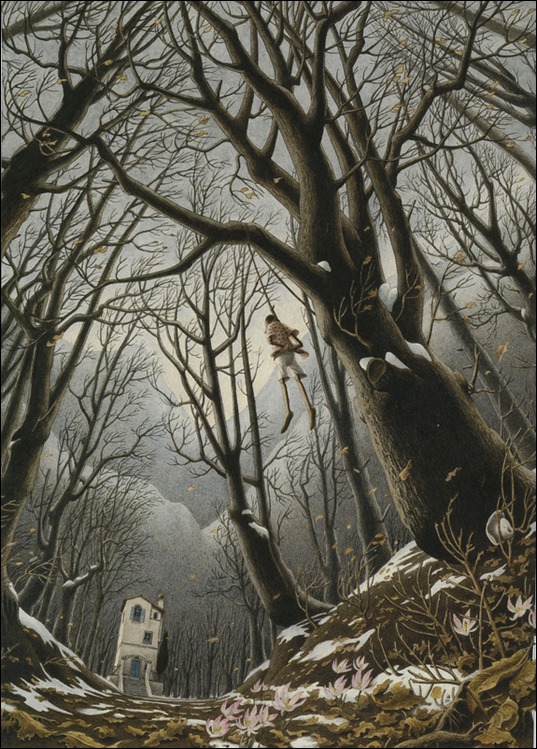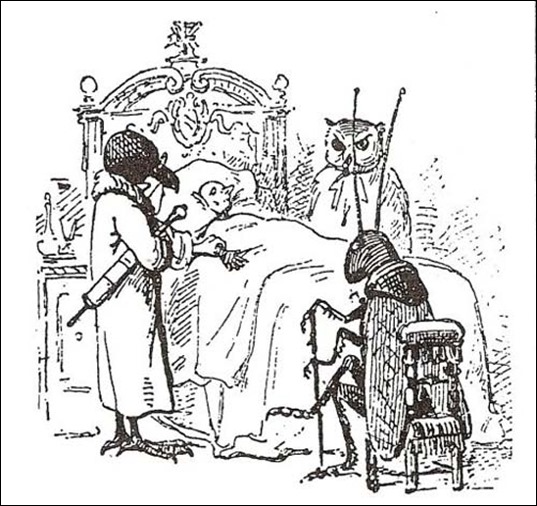Pinocchio Part 2 – The Doctor’s Diagnosis Posted by Geoff on Jan 23, 2014 in Italian Language
In part 1, I took a look at the ‘real’ Pinocchio, as created by Carlo Lorenzini, better known as Collodi, and explained how I was finding the book surprisingly dark and sinister compared to the sugary Disney version that I grew up with. Were Italian children disturbed by this classic fairy tale? Perhaps, but they certainly wanted more of the same.
 |
| Pinocchio impiccato, by Roberto Innocenti |
Collodi’s masterpiece was originally published in instalments under the title Storia di un Burattino (Story of a Puppet) in the ‘Giornale per i Bambini’ (The Children’s Paper), between the 7th of July and 27th October 1881. Fifteen chapters in all, the last of which left his young readers with the tragic image of Pinocchio hung from a tree by Gli Assassini (The Assassins). However, there was such an outcry for more news about poor Pinocchio that Collodi was forced to extend the story for another 21 chapters, thus creating Le Avventure di Pinocchio (The Adventures of Pinocchio).
Like all great stories, Pinocchio’s is spiced with humour, and I particularly enjoyed the chapter in which “La bella Bambina dai capelli turchini fa raccogliere il burattino: lo mette a letto, e chiama tre medici per sapere se sia vivo o morto.” (The beautiful little girl with the turquois hair has the puppet brought to her: she puts him to bed and calls three doctors to find out if he is alive or dead). Here, with my humble translation into English, is the part where the doctors proclaim their prognoses.
 |
| Illustration by Enrico Mazzanti |
– Vorrei sapere da lor signori*, – disse la Fata, rivolgendosi ai tre medici riuniti intorno al letto di Pinocchio, – vorrei sapere da lor signori se questo disgraziato burattino sia morto o vivo!…
A quest’invito, il Corvo, facendosi avanti per il primo, tastò il polso a Pinocchio: poi gli tastò il naso, poi il dito mignolo dei piedi: e quand’ebbe tastato ben bene, pronunziò solennemente queste parole:
– A mio credere il burattino è bell’e morto: ma se per disgrazia non fosse morto, allora sarebbe indizio sicuro che è sempre vivo!
– Mi dispiace, – disse la Civetta, – di dover contraddire il Corvo, mio illustre amico e collega: per me, invece, il burattino è sempre vivo; ma se per disgrazia non fosse vivo, allora sarebbe segno che è morto davvero!
– E lei non dice nulla? – domandò la Fata al Grillo-parlante.
– Io dico che il medico prudente quando non sa quello che dice, la miglior cosa che possa fare, è quella di stare zitto. Del resto quel burattino lì non m’è fisonomia nuova: io lo conosco da un pezzo!…
Pinocchio, che fin allora era stato immobile come un vero pezzo di legno, ebbe una specie di fremito convulso, che fece scuotere tutto il letto
– I’d like to know gentlemen, – said the fairy, addressing herself to the three doctors gathered around Pinocchio’s bed, I’d like to know gentlemen if this poor puppet is dead or alive!….
At this invitation, the Crow, stepping forward first, felt Pinocchio’s wrist, then he felt his nose, then his little toe: and when he’d finished his examination, solemnly pronounced these words:
– In my opinion the puppet is good and dead: but if unfortunately he should turn out not to be dead, then it would be a sure sign that he’s still alive
– I’m sorry, – said the Owl, – to have to contradict my illustrious friend and colleague the Crow: but in my opinion the puppet is still alive; however if, unfortunately, he should turn out not to be alive, well, then it would be a sign that he’s really dead!
– And do you have nothing to say? – the fairy asked the Talking Cricket.
– I say that the best thing that a cautious doctor can do when he doesn’t know what he’s saying is to keep quiet. Besides, that puppet there isn’t unfamiliar to me: I’ve known him for some time!
Pinocchio, who up until then had been as still as a real piece of wood, gave a kind of convulsive shudder that shook the whole bed.
*lor signori: lor is short for ‘loro’ and is an antiquated plural form of ‘lei’ (‘you’ formal), now substituted by ‘voi’ (you plural). The expression ‘Lor Signori’ (Literally: You Gentlemen) shows a very high level of politeness and reverence, and for this reason is still used today in an ironic way.
I hope I’ve whetted your appetites for Le Avventure di Pinocchio. You can find the original Italian text in PDF form here, but if you can’t manage the story in Italian there is a highly rated English/Italian side by side version available: The Adventures of Pinocchio (Le Avventure Di Pinocchio) (Biblioteca Italiana)

Build vocabulary, practice pronunciation, and more with Transparent Language Online. Available anytime, anywhere, on any device.




Leave a comment: